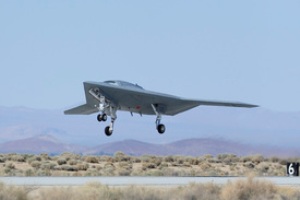Northrop Grumman and the U.S. Navy concluded testing at Edwards Air Force Base, California, on May 15, successfully achieving the first phase of flight testing of the X-47B Unmanned Combat Air System (UCAS) demonstrator aircraft.
 U.S. Navy, Northrop Grumman Complete X-47B Flight Testing at Edwards Air Force Base, Move Second Unmanned Aircraft to East Coast
U.S. Navy, Northrop Grumman Complete X-47B Flight Testing at Edwards Air Force Base, Move Second Unmanned Aircraft to East Coast
The airworthiness test phase included 23 flights by two air vehicles, which proved the capability of the X-47B to perform efficiently at all altitudes, speeds, and weights involved within the Navy's Unmanned Combat Air System Carrier Demonstration (UCAS-D) program. Tests of various aircraft maneuvers that a carrier environment entails were included in the flights, ensuring minimal risks associated with running an unmanned aircraft.
Northrop Grumman serves as the Navy's chief contractor for the UCAS-D program.
The X-47B aircraft reached altitudes over 15,000 ft at Edwards. Several maneuvers relevant to carrier operations were demonstrated. They included extending and retracting a tail hook, achieving an autonomous "touch-and-go" landing and completing landings in a heavy weight configuration at a high sink rate.
At present, the Northrop Grumman team is finalizing the software necessary for permitting carrier suitability testing of the X-47B. Catapult launches, wireless remote deck handling of the aircraft, and arrested landings will be included in the testing.
After moving to Patuxent River during last December, the first X-47B is being subjected to electromagnetic interference testing, wherein the X-47B will be proven compatible with the aircraft carrier’s electromagnetic signal environment.
During 2013, the UCAS-D program intends demonstrating the potential of tailless, autonomous, low-observable relevant X-47B demonstrator to securely operate from a Navy aircraft carrier. Launch, recovery, bolter and wave-off performance will also be included. Autonomous aerial refueling by the X-47B is scheduled in 2014.